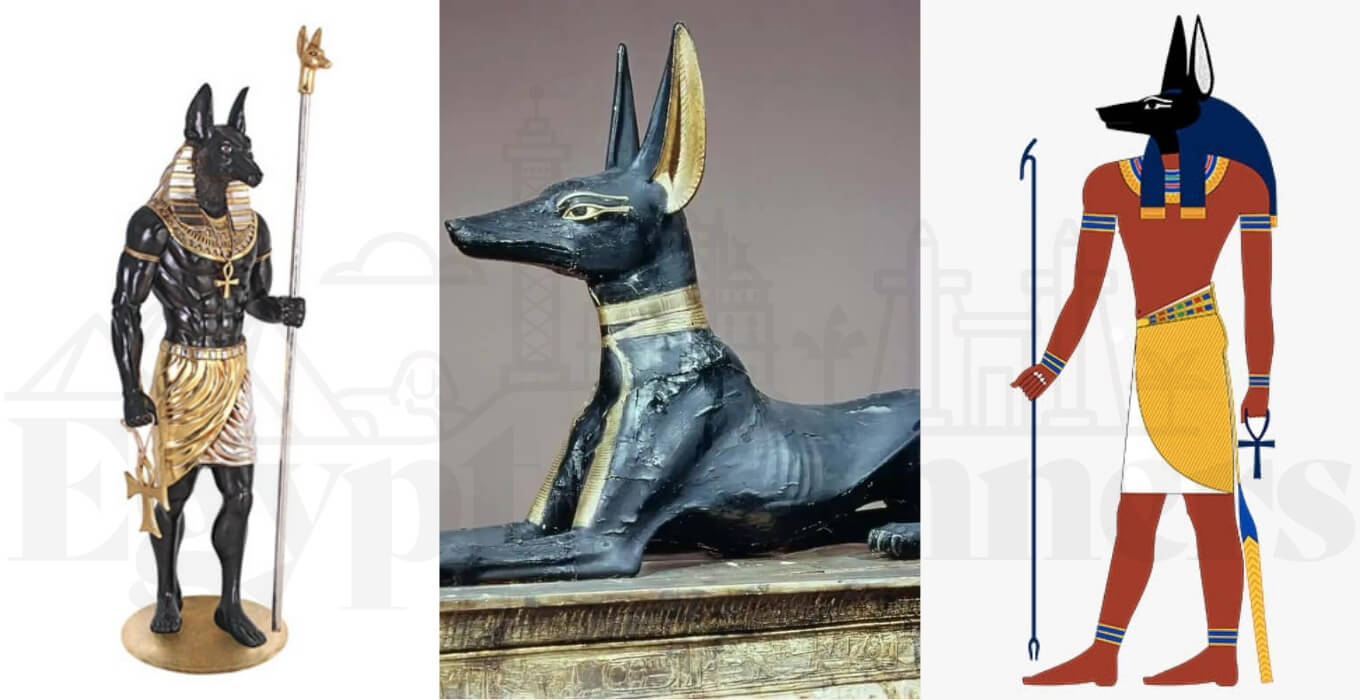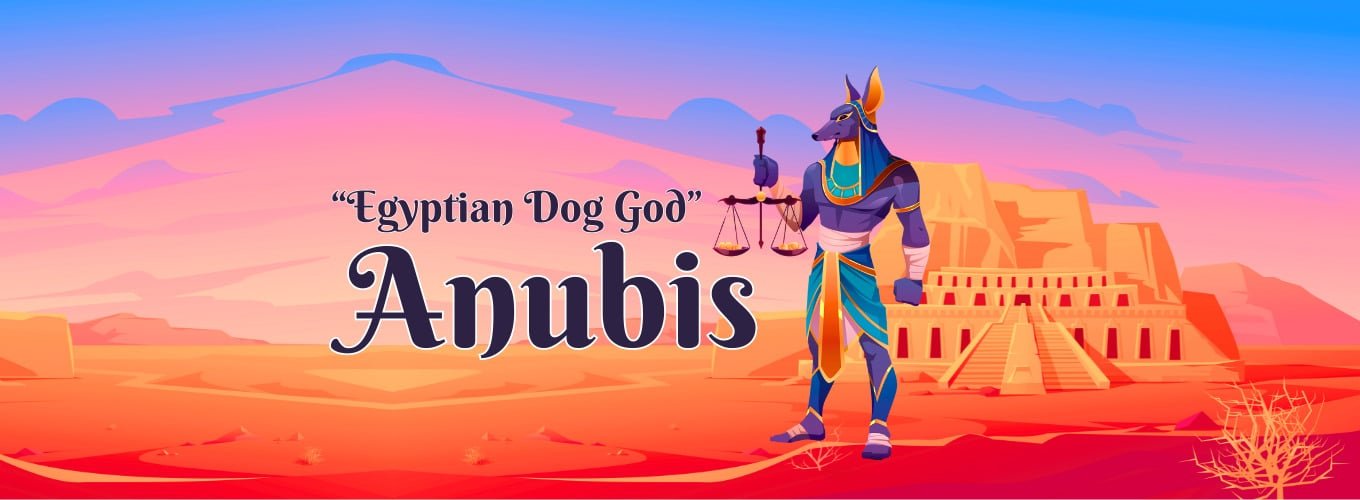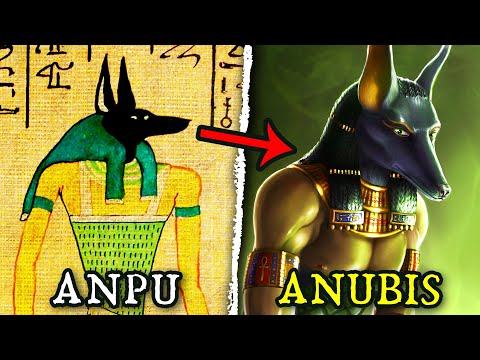Anubis Egyptian Dog God, is not typically depicted with a dog head; rather, he is often represented with the head of a jackal or a wild dog. Anubis is an ancient Egyptian dog deity associated with mummification and the afterlife. He is usually depicted as a black or black-and-golden jackal or dog-headed figure, and he played a crucial role in the funerary practices of ancient Egyptian history.
The Egyptian god with a dog head, “Egyptian Anubis dog,” was believed to guide and protect the souls of the deceased during their journey through the afterlife. He was also associated with the weighing of the heart ceremony, where a person’s heart was weighed against the feather of Ma’at to determine their worthiness for entry into the afterlife.
It’s important to note that there are other gods in Egyptian mythology with animal heads, each carrying specific symbolism and attributes.
Key Takeaways
- Anubis was the ancient Egyptian god associated with death, mummification, and the afterlife.
- He was often depicted with the head of a jackal or dog-like creature, with a black coat.
- Anubis played a pivotal role in funerary rites and rituals, guiding the souls of the deceased to the afterlife and overseeing the embalming process.
- Anubis was one of the most frequently depicted and revered deities in the Egyptian pantheon, with a long history dating back to the First Dynasty.
- The god Anubis was closely associated with the concept of the afterlife and the transition from the world of the living to the world of the dead.
You can benefit from our discounted offers through the following All Inclusive Vacations to Egypt
- 7-Day Cairo with Nile Cruise Tour Package Get -100 USD
- 8 Days Cairo with 3 Nights Nile Cruise by Flight Get 10% Off + Free Activities
- 8 Days Cairo and Nile Cruise Holidays with Abu Simbel Get 7% OFF
- 10-Day Cairo, Alexandria, and Nile Cruise with Abu Simbel by Flight Get 10% OFF
Origins and Parentage of Dog Egyptian God
The story of Anubis, an ancient Egyptian dog god, is full of myths. These myths show how Egyptian beliefs changed over time. Anubis was first seen as the god of the dead. Later, Osiris took that role, and Anubis became the god of mummification and Osiris’s half-brother.
Anubis as the Son of Ra and Nephthys
At first, Anubis was thought to be the son of Ra, the sun god, and Nephthys. He was seen as a loyal follower of ISIS and a brave warrior. He beat the god Set in battle.
Anubis as the Son of Osiris and Nephthys
Another story said Anubis was the son of Osiris, the god of the underworld, and Nephthys. This story links to the Osiris myth, where Anubis helped Isis prepare Osiris for the afterlife. Some believed Anubis was Osiris’s illegitimate son, later adopted by Isis.
These different stories show how ancient Egyptian myths changed and grew. They highlight the diverse views of Anubis’s origins across different times and places.
| Parentage of Anubis | Description |
| Son of Ra and Nephthys | Anubis was depicted as the son of the sun god Ra and the goddess Nephthys in early Egyptian mythology. |
| Son of Osiris and Nephthys | Anubis was also portrayed as the son of Osiris, the god of the underworld, and Nephthys in the Osiris myth. |
| Illegitimate son of Osiris and Nephthys, adopted by Isis | Some sources suggest Anubis was the illegitimate son of Osiris and Nephthys, later adopted by the goddess Isis. |
The Name and Epithets of Egyptian Dog Meaning

Anubis, the dog god of Egypt, the ancient Egyptian god of the dead, has a rich history. He is known by many names and titles. The Greek name “Anubis” is well-known, but his Egyptian names were “Anpu” or “Inpu.” His name means “a royal child,” showing his high status in Egyptian religion.
Anubis had many epithets and titles that show his different roles. Some key ones are “Lord of the Necropolis,” “Lord of the Sacred Land,” and “He Who is Upon his Sacred Mountain.” He was also known as “Ruler of the Nine Bows,” “The Dog who Swallows Millions,” “Master of Secrets,” and “He Who is in the Place of Embalming.” These names highlight his importance in funerary rites and the underworld.
| Anubis Epithets and Titles | Meaning and Significance |
| “Lord of the Necropolis” | Anubis’s role as the ruler and guardian of the ancient Egyptian cemeteries and burial sites |
| “Lord of the Sacred Land” | Anubis’s authority over the sacred and consecrated lands associated with the afterlife and burial practices |
| “He Who is Upon his Sacred Mountain” | Anubis’s association with the sacred mountains where the dead were interred |
| “Ruler of the Nine Bows” | Anubis’s dominion over the nine foreign lands and peoples surrounding ancient Egypt |
| “The Dog who Swallows Millions” | Anubis’s role as the guardian and protector of the dead, consuming the souls of the unrighteous |
These epithets and titles show how Anubis, the ancient Egyptian dog god, was important. They highlight his deep significance in the region’s religion and culture.
Symbolism and Representation of Anubis
In ancient Egyptian mythology, Anubis was a unique god. He had a head like a jackal or dog. This made him closely tied to death and mummification.
Anubis with the Head of a Jackal or Dog
Anubis looked like a jackal or dog because of his link to wild animals. These animals were seen around cemeteries. They helped to connect Anubis with death and the afterlife.
The Black Color and Its Significance
Anubis Egyptian dog was often shown with a black coat. This color meant a lot in ancient Egypt. It stood for new life, the fertile Nile, and the dead body’s change after being mummified.
Anubis’s look, with his jackal or dog head and black skin, made him very important. These features showed his link to death and the afterlife. They also showed his deep role in ancient Egyptian beliefs.
Roles and Responsibilities of Anubis
Anubis, the jackal-headed god, was key in ancient Egyptian funerary rites. He was the god of embalming. Anubis made sure the dead’s body was preserved for the afterlife.
Anubis was also the protector of graves and the necropolis. He was known as the “Foremost of the Westerners” and the “Lord of the Sacred Land.” These titles showed he guarded the desert cemeteries where the dead rested.
Anubis as the Embalmer and Protector of Graves
Anubis was vital in ancient Egyptian beliefs. He was often shown helping the mummy, making sure it was properly mummified. He also did the Opening of the Mouth ceremony, getting the soul ready for the afterlife.
Anubis protected the necropolis, too. He kept tombs and graves safe from harm. This was key to the Egyptians’ beliefs about keeping the body safe and the importance of funerary rites.
Egyptian Dog God: Ancient Egyptian Dog Mythology
Anubis, the dog-headed god, was a key figure in ancient Egyptian myths. He helped the goddess Isis with Osiris’s body after he was killed by Set. This act showed his importance in myths about the afterlife.
Anubis also faced Set in another story. He protected Osiris’s body and marked Set’s skin as a warning. This showed he was a guardian of the dead and the underworld.
The Egyptians loved dogs, especially those like jackals. They mummified many dogs in Saqqara, showing how much they honored Anubis. This shows how important the dog god was in their beliefs about the afterlife.
| Anubis Mythology | Key Facts |
| Anubis in the Osiris Myth | Assisted Isis in embalming and restoring the body of Osiris after he was killed by Set |
| Anubis Confronting Set | Protected the body of Osiris and branded Set’s skin as a warning against desecrating the dead |
| Mummified Animals in Saqqara | Over 90% of the mummified animals discovered were dogs, honoring Anubis |
Anubis was deeply revered by the ancient Egyptians. He was linked to the underworld, death, and the afterlife. Many artifacts and depictions show his importance in their culture.
From the Anubis Shrine of Tutankhamun to dog-like breeds like the Pharaoh Hound and the Xolo, Anubis’s influence is clear. He left a lasting mark on Egyptian mythology and culture.
Anubis and the Weighing of the Heart Ceremony
In ancient Egypt, Anubis played a big role in the “Weighing of the Heart” ceremony. This ritual was key to deciding if a soul could enter the afterlife. Anubis, with his jackal head, guided the soul. He weighed their heart against the feather of Maat, the goddess of truth and justice.
If the heart was lighter than the feather, the soul was good to go into the afterlife. But if the heart was heavier, the soul was doomed to eternal damnation. The soul would be eaten by the Devourer, a scary goddess of the underworld. Anubis was crucial in this judgment, helping souls on their way to the afterlife.
The Hall of Double Truth and the Judgment
The Weighing of the Heart happened in the Hall of Double Truth. Here, the deceased’s heart was weighed against Maat‘s feather. Anubis and Thoth watched over this, known as psychostasia. If the heart matched the feather, the soul could move on to the underworld judgment and join Osiris. But if the heart was too heavy, the devil would eat it, sending the soul to eternal damnation.
- Anubis, the jackal-headed god, was the overseer of the Weighing of the Heart ceremony
- The ceremony took place in the Hall of Double Truth, where the deceased’s heart was weighed against the feather of Maat
- If the heart was in balance, the soul was deemed worthy and allowed to pass into the underworld judgment and the realm of Osiris
- If the heart was heavier, it was devoured by the Devourer, condemning the soul to eternal damnation
Anubis: Guide of Souls to the Afterlife
In ancient Egyptian mythology, Anubis, the jackal-headed god, was a key figure. He was known for his roles as the embalmer and protector of graves. Anubis also guided souls into the afterlife.
Anubis was shown holding the hand of the dead, leading them through death’s darkness. He was a comforting and protective figure. His role was crucial in ancient Egyptian beliefs, where the afterlife journey was full of dangers.
Anubis helped ensure the soul’s safe journey to the underworld and the realm of Osiris.
Anubis is one of the oldest gods in ancient Egypt, dating back around 5,000 years ago. He was a psychopomp, guiding souls from the earthly plane to the spiritual realm.
| Anubis’ Roles and Responsibilities | Significance |
| Guiding souls to the afterlife | Ensured the safe passage of the soul to the realm of Osiris and the underworld |
| Attending the scales during the Weighing of the Heart ceremony | Determined the purity of the deceased’s heart against the Feather of Ma’at |
| Inventor of mummification | Played a crucial role in the process of death and renewal in ancient Egyptian beliefs |
| Guardian of tombs and sacred places | Provided protection and justice for the deceased and their final resting places |
Anubis offered protection, love, and authority. He was a guide to the mysteries of death and rebirth. His link to death and embalming showed his role in Egyptian mythology.
As a deity tied to cemeteries and embalming, Anubis’s worship highlighted the importance of transition. It showed the significance of this journey for individuals and society.
Depictions and Artwork of Anubis
Egyptian god dog head, the jackal-dog-headed Egyptian god, is often seen in the region’s art. He is shown in statues and tomb paintings. These show him sitting, guarding tombs, or helping with the dead.
Statues and Tomb Paintings of Anubis
Anubis was known for his black color and jackal head. He was a powerful symbol in ancient Egyptian art. Statues of him were found in temples and tombs, asking for his help and protection.
Tomb paintings showed Anubis guiding souls to the afterlife. They also showed him helping with the mummification process. This showed his key role in death rituals and the journey to the afterlife.
| Artwork Type | Anubis Depictions | Significance |
| Statues | Jackal-headed figure, often seated or standing guard | Invoked Anubis’ presence and protection in temples and tombs |
| Tomb Paintings | Guiding souls to the afterlife, attending mummification | Emphasized Anubis’ role in funerary rites and the journey to the next world |
The many Anubis artworks, Anubis statues, and Anubis tomb paintings show how important Anubis was in ancient Egyptian art. They highlight the significance of the jackal-headed god depictions in the culture.
Anubis and His Relationship with Other Deities
In ancient Egyptian mythology, Anubis was deeply connected with many gods. He was especially close to Osiris and Isis. These relationships made him the guardian of the dead and the god of funerary rites.
Anubis, Osiris, and Isis
Anubis helped Isis in the Osiris myth. Together, they embalmed and brought Osiris back to life. This made Anubis a key figure in afterlife rituals. He was also linked to Isis, the goddess of magic, who took him in after his mother, Nephthys, left him.
His bond with Osiris and Isis showed his importance in ancient Egyptian beliefs. Anubis guided the dead through the afterlife and was key in funerary rites. He became a crucial part of the underworld deities and funerary deities in the ancient Egyptian pantheon.
“Anubis was the one who conducted the dead into the judgment halls of Amenti, and he who weighed their hearts against the feather of truth.”
The anubis relationship with other gods, especially with anubis osiris relationship and anubis isis relationship, shows the deep connections in the ancient Egyptian pantheon. These gods played big roles in the afterlife beliefs of the ancient Egyptians.
FAQs: Egyptian Dog God
What is the name of the Egyptian dog god?
The Egyptian dog god’s name is Anubis. In ancient Egyptian, he was originally called Inpu or Anpu.
What Egyptian god has a dog head?
Anubis is the Egyptian god who is depicted with a dog head, specifically the head of a jackal.
Why does Anubis have a dog head?
Anubis has a dog’s head because jackals were often seen around cemeteries in ancient Egypt. The Egyptians believed that the jackal was a protector of graves, which is why Anubis, as the god of mummification and the afterlife, was depicted with a jackal head to symbolize his role in protecting and guiding the dead.
Why is Anubis the god of death?
Anubis is considered the god of death because he played a crucial role in the ancient Egyptian afterlife. He was responsible for overseeing the embalming process, protecting the dead, and guiding souls to the afterlife. Anubis also performed the weighing of the heart ceremony, which determined whether a soul was worthy of entering the afterlife.
Is Anubis good or bad?
Egyptian dog-headed god is neither inherently good nor bad. He is viewed as a neutral figure in Egyptian mythology, serving as a protector and guide for the dead. His primary role is to ensure that the deceased are properly prepared for the afterlife and to judge their worthiness fairly.
Conclusion: Egyptian Dog God Anubis
Anubis, the Egyptian dog-headed god, was key in ancient Egyptian myths and beliefs. He was the god of death, mummification, and the afterlife. Anubis helped guide souls to the underworld and to Osiris’s realm.
His look, with a jackal or dog head and black skin, made him stand out. This look made him a strong symbol in Egyptian art and death rituals.
Anubis did many important jobs, like preparing the dead for the afterlife and judging their hearts. This made him a top god in Egyptian beliefs and a key figure in their afterlife stories.
The Egyptians really respected Anubis and had many rituals for him. These rituals showed how much they believed in the afterlife and honoring the dead. Anubis’s role as a guide to the underworld still interests scholars and amazes people today. This shows how important this Egyptian god still is.
Related Articles: You can learn more about the history of ancient Egypt through our following article:
- Eye of Horus vs Eye of Ra
- 42 Ancient Egyptian Amulets
- 30 Important Ancient Egyptian Symbols
- Top 5 Egyptian Symbols for Power
- Top 8 Egyptian Symbols for Strength
- Top 15 Ancient Egyptian Good Luck Symbols
- Top 28 Egyptian Symbols Of Protection
- Revered Animals in Ancient Egypt NYT
- List of 22 Ancient Egyptian Pharaohs
- Ancient Egyptian Goddess Bastet


